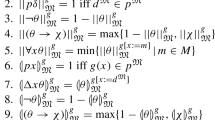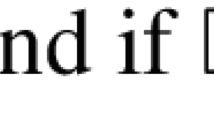Abstract
We formulate a Curry-typed logic with fine-grained intensionality within Turner’s typed predicate logic. This allows for an elegant presentation of a theory that corresponds to Fox and Lappin’s property theory with curry typing, but without the need for a federation of languages. We then consider how the fine-grained intensionality of this theory can be given an operational interpretation. This interpretation suggests itself as expressions in the theory can be viewed as terms in the untyped lambda-calculus, which provides a model of computation.
Similar content being viewed by others
Notes
See Fox and Lappin (2005), Chap. 5 for discussion of the paradoxes.
As we shall see, the interpretation of intensionality with the untyped \(\lambda \)-calculus is consistent with an operational interpretation of intensionality.
Among other things, this formalisation of PTCT shows how the presentation of the theory need not be bound to an explicit interpretation of intensional terms as \(\lambda \)-terms in the logic.
In the original presentation, the language of wffs was expressed in conventional logical syntax. The language of intensions then had to be distinguished from this.
Elsewhere, “Typed Predicate Logic” is sometimes used to refer to constructive theories such as Martin-Löf (1984)’s Type Theory (MLTT). This is not the use intended here.
Here the sequents can involve just that part of the context \(\Gamma \) that concerns type judgements. This could be made explicit if we wished to demonstrate that particular syntactic judgements are independent of their logical behaviour.
The logical paradoxes of self-application are avoided because of the typed equality/identity relation, typed quantification, and the absence of a universal type and “free-floating” type judgements within the language of PTCT propositions. There are other ways the hierarchy of types could be formulated. For example, we could characterise \(\Lambda \) as a type of types which includes \(\tau \). That is, if \(T:\tau \), then \(T:\Lambda \).
If we were to remove \(\sigma \) from the theory, then we would need to amend the rules so that \(B\) and \(\pi \) where made members of \(\tau \) directly, rather than via their membership of \(\sigma \).
We define identity in PTCT in terms of \(\lambda \)-identity, although this is not essential.
If we were also to add pairings and projections to PTCT, we could “uncurry” this type, and represent it as \(\Pi X\cdot (X,X)\Rightarrow X\).
See Fox and Lappin (2005) for a discussion of inscriptionalist theories of intentionality.
See Pereira and Shieber (1987) for an explanation of Definite Clause Grammars. The DCG in (7) is from Gazdar and Mellish (1989). Matthew Purver and Shalom Lappin constructed the DCG in (8) as a Prolog programming exercise for a computational linguistics course that Shalom Lappin gave in the Computer Science Department at King’s College London in 2002.
See Martin-Löf (1984) for a type theory in which propositions are characterised as proofs in a formal system.
Duží et al. (2010) also adopt an operational view of hyperintensionality within Tichý (1988)’s Transparent Intensional Logic (in the form of “constructions”). However, the computational details of their account are left largely unspecified. Both Muskens (2005) and Duží et al. (2010) regard their respective proposals as working out Frege (1892)’s idea that a sense is a rule for identifying the denotation of an expression.
Fox and Lappin (2005) point out that Thomason’s logic is problematic because it does not characterize the algebraic structure of the domain of propositions. It does not offer a proof theory that defines entailment for propositions, and so it leaves the relation between intentional identity and extensional equivalence crucially under determined.
Fox et al. (2002); Fox and Lappin (2005); Pollard (2008) adopt a similar view for the fine-grained higher-order logics that they construct. They define worlds as untrafilters in the prelattice of propositions, and they take the truth of a proposition, relative to a world, to be its membership in such an ultrafilter. As entailment in the prelattice is defined by a preorder, distinct propositions can belong to the same set of ultrafilters.
We are using Moschovakis’ notation here.
References
Aczel, P. (1980). Frege structures and the notions of proposition, truth and set. In J. Barwise, Keisler, & E. Keenan (eds.), The Kleene Symposium, North Holland Studies in Logic, North Holland (pp. 31–39).
Carnap, R. (1947). Meaning and necessity. Chicago: University of Chicago Press.
Church, A. (1940). A formulation of the simple theory of types. The Journal of Symbolic Logic, 5(2), 56–68.
Cooper, R. (2012). Type theory and semantics in flux. In R. Kempson, T. Fernando, & N. Asher (Eds.), Philosophy of linguistics (pp. 271–323). Amsterdam: Elsevier.
Curry, H. B., & Feys, R. (1958). Combinatory logic, Vol. 1 of studies in logic. Amsterdam: North Holland.
Duží, M., Bjorn, J., & Pavel, M. (2010). Procedural semantics for hyperintensional logic. Dordrecht: Springer.
Fox, C. (2000). The ontology of language. CSLI Lecture Notes, CSLI, Stanford.
Fox, C., & Lappin, S. (2005). Formal foundations of intensional semantics. Oxford: Blackwell.
Fox, C., & Lappin, S. (2010). Expressiveness and complexity in underspecified semantics. Linguistic Analysis, 36, 385–417.
Fox, C., Lappin, S., & Pollard, C. (2002). A higher-order, fine-grained logic for intensional semantics. In G. Alberti, K. Balough, & P. Dekker (Eds.), Proceedings of the Seventh Symposium for Logic and Language (pp. 37–46). Pecs: Hungary.
Frege, G. (1892). On sense and reference. In P. Geach & M. Black (Eds.), Translations from the Philosophical Writings of Gottlob Frege (3rd ed., pp. 56–78). Oxford: Basil Blackwell.
Gallin, D. (1975). Intensional and higher-order modal logic. Amsterdam: North-Holland.
Gazdar, G., & Mellish, C. S. (1989). Natural language processing in prolog. Waltham, MA: Addison-Wesley.
Lappin, S. (2012). An operational approach to fine-grained intensionality, In T Graf, D Paperno, A Szabolcsi, & J Tellings (eds.), Theories of everything: In Honor of Ed Keenan, UCLA Working Papers in Linguistics, no. 17 (Creative Commons Non-Commercial License). http://creativecommons.org/licenses/by-nc/3.0/.
Lappin, S. (2013). Intensions as computable functions. Linguistics Issues in Language Technology, 9, 1–12.
Martin-Löf, P. (1984). Intuitionistic type theory, studies in proof theory (Lecture Notes). Napoli: Bibliopolis.
Montague, R. (1974). In R. H. Thomason (Ed.), Formal philosophy: Selected papers of Richard Montague. New Haven, CT: Yale University Press.
Moschovakis, Y. N. (2006). A logical calculus of meaning and synonymy. Linguistics and Philosophy, 29, 27–89.
Muskens, R. A. (2005). Sense and the computation of reference. Linguistics and Philosophy, 28, 473–504.
Pereira, F. C. N., & Shieber, S. M. (1987). Prolog and natural-language analysis. CSLI Lecture Notes Series, Vol. 10, Center for the Study of Language and Information.
Pollard, C. (2008). Hyperintensions. Journal of Logic and Computation, 18, 257–282.
Thomason, R. H. (1980). A modeltheory for propositional attitudes. Linguistics and Philosophy, 4, 47–70.
Tichý, P. (1988). The foundations of Frege’s logic. Berlin: De Gruyter.
Turner, R. (1992). Properties, propositions and semantic theory. In M. Rosner & R. Johnson (Eds.), Computational linguistics and formal semantics. Studies in natural language processing (pp. 159–180). Cambridge: Cambridge University Press.
Turner, R. (2005). Semantics and stratification. Journal of Logic and Computation, 15(2), 145–158.
Turner, R. (2008). Computable models. Journal of Logic and Computation, 18(2), 283–318.
Turner, R. (2009). Computable models. London: Springer-Verlag.
Author information
Authors and Affiliations
Corresponding author
Additional information
The Introduction and Sect. 3 are based on Lappin (2012, 2013) The main ideas for Sect. 3 developed out of Shalom Lappin’s NASSLLI 2012 course “Alternative Paradigms of Computational Semantics”, and from talks that he gave at the University of Gothenburg in April 2012, and in December 2012. He is grateful to the participants in the course and to the audiences of the talks for stimulating feedback. We would also like to thank Robin Cooper, and Dag Westerståhl for very helpful discussion of some of the issues addressed here.
Rights and permissions
About this article
Cite this article
Fox, C., Lappin, S. Type-theoretic logic with an operational account of intensionality. Synthese 192, 563–584 (2015). https://doi.org/10.1007/s11229-013-0390-1
Received:
Accepted:
Published:
Issue Date:
DOI: https://doi.org/10.1007/s11229-013-0390-1




